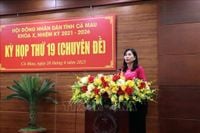On April 28, 2025, the Ministry of Home Affairs held a regular press conference in Hanoi, announcing significant changes in the administrative structure of local governments across Vietnam. The new policy grants local authorities complete autonomy in naming and arranging personnel for commune-level administrative units following a recent decentralization initiative.
According to Mr. Phan Trung Tuan, Director of the Department of Local Government, this decision stems from the provisions outlined in Resolution No. 76/2025/UBTVQH15. Local governments are now empowered to proactively name and rename their administrative units, ensuring that the names reflect local realities, are easy to read and remember, and align with historical and cultural factors. This shift is designed to enhance local governance and foster community support.
The National Assembly Standing Committee has encouraged localities to adopt names based on ordinal numbers or the names of pre-rearrangement district-level units, facilitating digitalization and data management. Importantly, a commune-level unit's name must not duplicate any other name at the same administrative level within the province or in any newly formed provinces after rearrangement.
Mr. Tuan emphasized that local authorities could choose to retain old names, use names of notable figures, or opt for names reflecting the district-level units. “The decision regarding whether to include numbers in the naming process is entirely up to the local government, aiming to achieve effective management and community consensus,” he stated.
In terms of personnel arrangements, the current staffing levels will be maintained initially, with district-level officials being transferred to commune-level positions. Mr. Pham Trung Tuan reiterated the principle guiding this process: “locality decides, locality does, locality takes responsibility.” This approach grants local governments the authority to determine the staffing of their administrative units, including key positions such as the Secretary or Chairperson of new communes.
The Ministry of Home Affairs has articulated that the merger of provinces and the reorganization of commune-level administrative units is not merely a mechanical adjustment of administrative boundaries. Instead, it aims to reorganize development spaces and management systems, enhancing the operational model of local governance in line with strong decentralization and devolution policies.
The overarching goal is to reduce the number of administrative units, streamline organizational structures, and ensure stability while fostering innovation and development. This realignment is expected to promote local potential and advantages, expanding development spaces to meet the socio-economic development strategy of the country.
On the same day, the People's Council of Binh Dinh province convened its 23rd session, where it approved the rearrangement of commune-level administrative units. This resolution aligns with the aspirations of local voters, who have expressed a preference for naming new communes and wards based on local geographic and historical significance rather than ordinal numbers.
Following the restructuring, Binh Dinh will have 58 administrative units, comprising 41 communes and 17 wards, reflecting a reduction of 62.58%. The changes aim to enhance the identification of local names with historical and cultural significance, ensuring easier recognition by residents.
In Dong Thap province, the People's Council also passed a resolution to rearrange 45 commune-level administrative units, consolidating the governance structure to enhance the effectiveness of local administration. This decision was made following extensive consultations with voters, who showed overwhelming support for the rearrangement.
Similarly, in Hanoi, the authorities reported a remarkable 96% public consensus on the proposed naming scheme for new wards and communes during the restructuring process. Mr. Tran Dinh Canh, Director of the Hanoi Department of Home Affairs, noted that 38 units achieved a 100% consensus rate on the rearrangement plan.
Hanoi's approach includes retaining the names of 30 districts as models for naming new wards, ensuring that historical and cultural values are preserved. The city plans to reduce the number of grassroots-level administrative units by nearly 76%, surpassing the central government's target of 60-70% reduction.
In Hoang Hoa district, local authorities conducted a specialized session to discuss the naming of new communes, achieving a consensus rate of 91.1% among voters. The district plans to reduce its number of communes from 36 to 8, with new names reflecting local cultural and historical identities.
As part of the restructuring, the provinces of Binh Dinh and Gia Lai are also set to merge, creating a new administrative unit under the central government. This newly formed province will encompass the combined territories and populations of both provinces, with an estimated area of 21,576 km² and a population of approximately 3.58 million people.
The new administrative center will be located in Quy Nhon city, and the merger aims to streamline governance and enhance service delivery to residents. The arrangement of personnel post-merger will be managed according to centralized regulations, ensuring a smooth transition while maintaining current staffing levels initially.
Overall, these changes reflect a significant shift towards empowering local governments in Vietnam, allowing them to take greater control over their administrative structures and fostering a sense of community involvement in governance.






